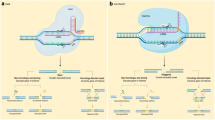Summary
In most strains of Caenorhabditis elegans with a low copy number of Tc1 transposable elements, germline transposition is rare or undetectable. We have observed low-level Tel transposition in the genome of the C. elegans var. Bristol strain KR579 (unc-13[e51]) resulting in an increase in Tc1 copy number and subsequent mutator activity. Examination of genomic blots from KR579 and KR579derived strains revealed that more Tc1-hybridizing bands were present than in other Bristol strains. A novel Tc1-hybridizing fragment was cloned from a KR579-derived strain. Unique sequence DNA flanking the Tc1 element identified a 1.6 kb restriction fragment length difference between the KR579 and N2 strains consistent with a Tc1 insertion at a new genomic site. The site of insertion of this Tel was sequenced and is similar to the published Tel insertion site consensus sequence. Several isolates of KR579 were established and maintained on plates for a period of 3 years in order to determine if Tc1 copy number would continue to increase. In one isolate, KR1787, a further increase in Tc1 copy number was observed. Examination of the KR1787 strain has shown that it also exhibits mutator activity as assayed by the spontaneous mutation frequency at the unc-22 (twitcher) locus. The KR579 strain differs from most low copy number strains in that it exhibits low-level transposition which has developed into mutator activity.
Similar content being viewed by others
References
Baillie DL, Beckenbach KA, Rose AM (1985) Cloning within the unc-43 to unc-31 interval (linkage group IV) of the Caenorhabditis elegans genome using Tc1 linkage selection. Can J Genet Cytol 27:457–466
Bingham PM, Kidwell MG, Rubin GM (1982) The molecular basis of P-M hybrid dysgenesis: the role of the P element, a P strainspecific transposon family. Cell 29:995–1004
Brenner S (1974) The genetics of Caenorhabditis elegans. Genetics 77:71–94
Clark DV, Johnsen RC, McKim KS, Baillie DL (1990) Tel induced mutations in essential genes in Caenorhabditis elegans using a mutator strain. Genome, in press
Eide D, Anderson P (1985a) The gene structures of spontaneous mutations affecting a Caenorhabditis elegans myosin heavy chain gene. Genetics 109:67–79
Eide D, Anderson P (1985b) Transposition of Tc1 in the nematode C. elegans. Proc Natl Acad Sci USA 82:1756–1760
Eide D, Anderson P (1988) Insertion and excision of Caenorhabditis elegans transposable element, Te1. Mot Cell Biol 8:737–746
Emmons SW, Yesner L (1984) High frequency excision of transposable element Te1 in the nematode Caenorhabditis elegans is limited to somatic cells. Cell 36:599–607
Emmons SW, Klass MR, Hirsh D (1979) Analysis of the constancy of DNA sequences during development and the evolution of the nematode Caenorhabditis elegans. Proc Nall Acad Sci USA 76:1333–1337
Emmons SW, Yesner L, Ruan K, Katzenberg D (1983) Evidence for a transposon in Caenorhabditis elegans. Cell 32:55–65
Emmons SW, Roberts S, Ruan KS (1986) Evidence in a nematode for regulation of transposon excision by tissue-specific factors. Mol Gen Genet 202:410–415
Engels WR (1979) Extrachromosomal control of mutability in Drosophila melanogaster. Proc Natl Acad Sci USA 79:4570–4574
Fedoroff NV (1988) Maize transposable elements. In: Berg D, Howe M (eds) Mobile Genetic Elements. American Society of Microbiology, Washington, DC, pp 375–411
Feinberg AP, Vogelstein B (1983) A technique for radiolabeling DNA restriction endonuclease fragments to high specific activity. Anal Biochem 132:6–13
Harris LJ, Rose AM (1986) Somatic excision of the transposable element Tel from the Bristol genome of Caenorhabditis elegans. Mol Cell Biol 6:1782–1786
Harris LJ, Rose AM (1989) Structural analysis of Tc1 elements in Caenorhabditis elegans var. Bristol (strain N2). Plasmid 22:10–21
Hattori M, Sakaki Y (1986) Dideoxy sequencing method using denatured plasmid templates. Anal Biochem 152:232–238
Liao LW, Rosenzweig B, Hirsh D (1983) Analysis of a transposable element in Caenorhabditis elegans. Proc Nail Acad Sci USA 80:3585–3589
Moerman DG, Waterston RH (1984) Spontaneous unc-22 IV mutations in C. elegans var. Bergerac. Genetics 108:859–877
Moerman DG, Waterston RH (1988) Mobile elements in Caenorhabditis elegans and other nematodes. In: Berg D, Howe M (eds) Mobile Genetic Elements. American Society of Microbiology Washington, DC, pp 537–556
Moerman DG, Benian GM, Waterston RH (1986) Molecular cloning of the muscle gene unc-22 in Caenorhabditis elegans by Tc1 transposon tagging. Proc Natl Acad Sci USA 83:2579–2583
Mori I, Moerman DG, Waterston RH (1988) Analysis of a mutator activity necessary for germline transposition and excision of Te1 transposable elements in Caenorhabditis elegans. Genetics 120:397–407
Rattray B (1986) Characterization of the recombination enhancer, rec-1, in Caenorhabditis elegans. MSc thesis, University of British Columbia, Vancouver, Canada
Rose AM, Baillie DL (1979) A mutation in Caenorhabditis elegans that increases recombination frequency more than three-fold. Nature 281:599–600
Rose AM, Snutch TP (1984) Isolation of the closed circular form of the transposable element Tc1 in C. elegans. Nature 311:485–486
Rosenzweig B, Liao LW, Hirsh D (1983) Sequence of the C. elegans transposable element Tc1. Nucleic Acids Res 2:4201–4209
Ruan K, Emmons SW (1984) Extrachromosomal copies of transposon Tc1 in the nematode C. elegans. Proc Natl Acad Sci USA 81:4018–4022
Sanger F, Nicklen S, Coulson AR (1977) DNA sequencing with chain-terminating inhibitors. Proc Natl Acad Sci USA 74:5463–5467
Southern EM (1975) Detection of specific sequences among DNA fragments separated by gel electrophoresis. J Mol Biol 98:503–517
Author information
Authors and Affiliations
Additional information
Communicated by J. Finnegan
Rights and permissions
About this article
Cite this article
Babity, J.M., Starr, T.V.B. & Rose, A.M. Tcl transposition and mutator activity in a Bristol strain of Caenorhabditis elegans . Molec. Gen. Genet. 222, 65–70 (1990). https://doi.org/10.1007/BF00283024
Received:
Issue Date:
DOI: https://doi.org/10.1007/BF00283024




